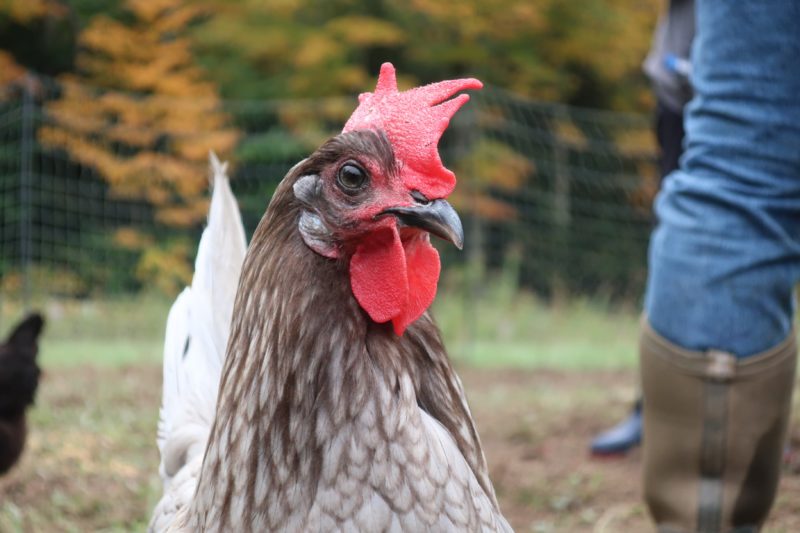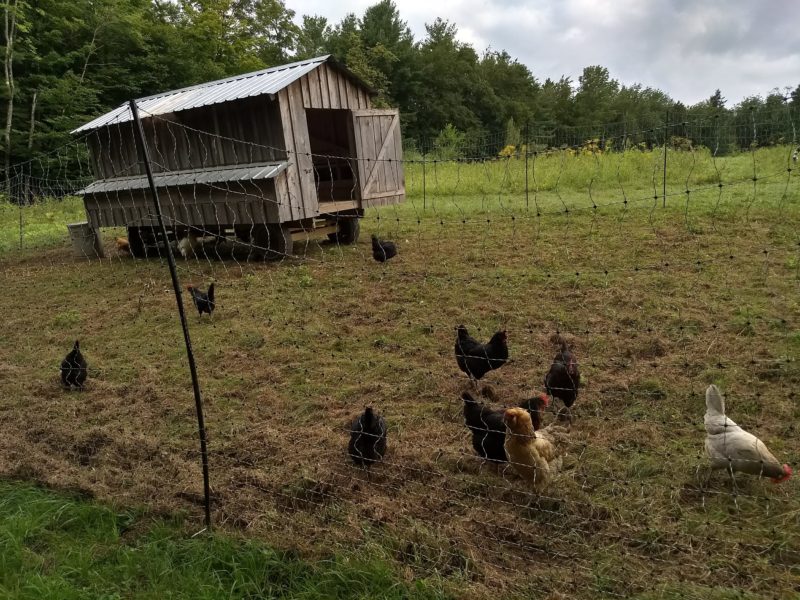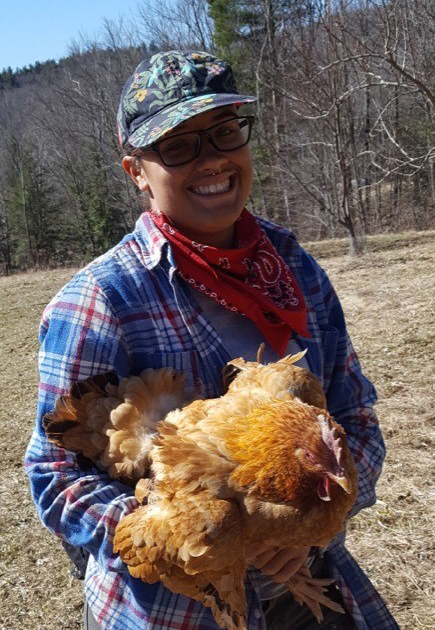Every day of my apprenticeship begins with tending the chickens at the farm. I grab a couple bags of feed and head out to the pasture, my cheeks tingling with the cool, crisp air; my boots drenched with dew. As the golden morning light slowly cascades over the wet grass, I greet our flocks of broilers and layers, move them to fresh pasture, and refill their feeders and water.
Gifts and Stewardship
Working with chickens reminds me of the sacrifice they make so that I can feed myself and my communities. Layers gift us with eggs, and broilers, spent hens, and old roosters gift us with their flesh to eat. As someone who raises chickens for eggs and processes them for meat, I am intimately aware of the relationship between life, death, and nourishment.

Stewardship means that I protect, manage, and am responsible for the well-being of these creatures I help serve. I consider myself a steward of both the chickens I raise and the pastures they roam. I manage the process by which the chickens enhance the pasture by introducing them to it and planning where and when they go. I am not the reason this process happens – I am just the manager. It is the land that works in concert with the chickens to produce and become food for others.
Having the honor to witness and facilitate this reciprocal relationship between chickens and pasture has taught me so much about how generous the land is. On the land lives the plants that capture sunlight to photosynthesize into food. The land is the home of the fungi that facilitate nutrient uptake for plant roots and the worms that break down organic matter, deposit castings in the soil, and provide a delicious treat for chickens. The land is host to oceans of fish, grasses that feed ruminants, and forests that shelter deer and provide timber. It provides for us in innumerable ways.
Offerings to the Land
The land offers us so much every day, and a way we can convey our appreciation for the land’s generosity is through making our own offerings to it. A land offering is a way of expressing gratitude and reverence for the abundance and protection the land provides us with. These gestures are a symbolic way we can celebrate and offer thanks to the spirits and deities that protect the land, as well as to the other beings that inhabit it and nourish us.
Offerings are an important component of many spiritual practices. In different traditions, they can take many forms, such as prayer, song, pouring libations in ritual, or presenting food or sacred objects. For me, the increased fertility I facilitate through thoughtful pasture rotations is one offering I make to the lands I steward.

Chicken manure is high in nitrogen and also contains significant amounts of phosphorus and potassium, so I plan my rotations with the goal of encouraging uniform manure deposition to increase pasture fertility. In contrast to continuous grazing where chickens would have unrestricted access to a section of land, through rotational management, the pasture is subdivided and the chickens are moved from one area to another, allowing previous sections to rest to avoid forage depletion or overfertilization. I have primarily raised chickens in chicken tractors and with ElectroNet fencing, so by utilizing those tools, I’m able to control where and how much manure the chickens deposit on pasture.
Managing these rotations has resulted in discernible changes to the quality of the pastures from year to year. I witnessed sections of the farms I worked where we pastured our chickens explode in vibrancy with bright-green forage in the summer and purple asters in the fall, as well as watched herbs, such as plantain and yarrow, proliferate.
Last year, I collaborated with my farm manager to integrate our laying hens into our annual crop rotation schedule. In some sections of the farm that lacked fertility, we introduced the layers to those areas for a couple weeks before we prepped and formed our beds. We calculated approximately how much manure the layers hypothetically deposited onto those sections, and used that calculation to determine what type and the amount of amendments we then needed to add to the soil before transplanting our seedlings. Soil amendments are often not locally sourced, which means that acquiring them requires the usage of fossil fuels to transport them to us, and the production of them is also resource-intensive. By integrating the layers into our crop rotation, we were able to reduce the amount of purchased inputs we needed to support the crops we grew that season, thereby reducing our carbon footprint in the process.
Restoring Right Relationship to Land

My relationship to agriculture is rooted in the reverence I have for the land, and this relationship is the compass by which I continue to refine and align my farming practices to actualize what right relationship to the land means to me. Through farming, I came to recognize that without the land’s generosity and grace, all of us who depend on the land for nourishment could not and would not exist. Unfortunately, many of us are disconnected from this reality.
In our current food system, the land is treated as a commodity, animals are seen as goods rather than sentient beings, and our foodways rely on the exploitation of farmworkers and incarcerated people. Much of the meat consumed in the U.S. comes from animals raised in concentrated animal feeding operations (CAFOs) that are partially responsible for the global increase in greenhouse gas emissions, and for widespread air and water contamination that primarily affects Black and Indigenous communities.
Animals in these facilities are often mistreated. Chickens are omnivores, but being confined indoors prevents them from accessing the diversified diet they thrive on. Because of the confined conditions, layers often get their beaks trimmed to prevent cannibalism that’s common in such stressful, cramped environments. Cornish Cross, a breed raised commercially on factory farms for meat, are popular for their large breasts that come at the expense of them gaining so much weight during their lifetimes that they often can’t support their body weights as they mature.
I think that restoring the right relationship to land, in which we don’t mine the land as a commodity and treat it and the other beings that inhabit it with dignity and respect, is an important component in moving away from industrial agriculture and toward a more regenerative ecological relationship. Reestablishing that relationship necessitates the collective understanding that we depend on the kindness and well-being of the land. Typically, when someone offers you a gift, we feel compelled to reciprocate and illustrate our gratitude in some way. Similarly, we can assume a similar stance with the land and the many beings we depend on for survival. Transforming this gratitude into intentional action to correct and atone for the degradation and destruction caused by industrial agriculture can be a major step in regenerating the environment.
Conveying gratitude, whether through symbolic or material offerings, is one way we can begin to shift our collective relationship to land and agriculture. Increased fertility, leading to healthier pastures and supporting the many organisms that live in the soil, via planning and executing rotational grazing of chickens on pasture, is a way I express gratitude to the land for nourishing me and my communities, and it keeps me grounded in establishing a reciprocal ecological relationship to the earth. Every morning when I shift my chickens to fresh pasture, I am reminded of the gifts we are granted every day.












